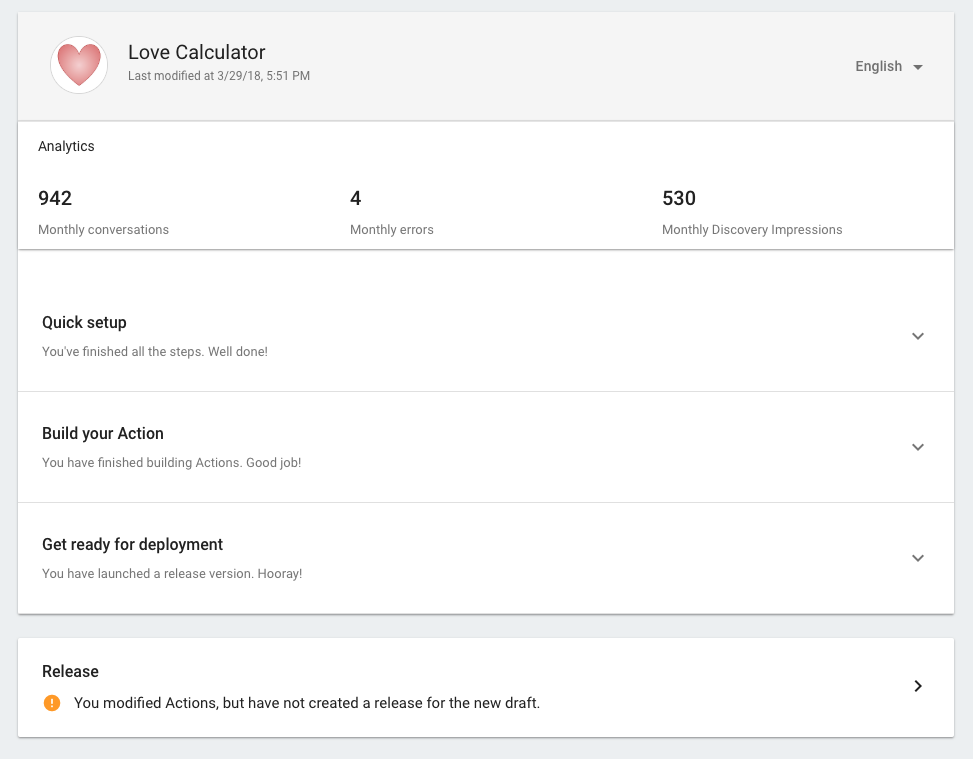Actions on Google을 사용하면 작업. 사용자는 작업을 통해 대화형 인터페이스를 통해 작업을 수행할 수 있습니다. 몇 가지 조명을 켜는 간단한 명령이나 좀 더 오래 켜져 있는 것을 일반적인 대화를 할 수 있습니다.
Actions SDK는 작업 없이 대화 처리를 개발하는 한 가지 방법입니다. 살펴봤습니다 Actions SDK를 사용할 때는 작업 패키지를 사용하여 인텐트를 fulfillment에 매핑합니다. 또한 사용자가 말할 수 있는 예시 문구를 정의하는 작업 패키지
gactions CLI
Actions SDK를 사용하여 개발할 때는 gactions 명령줄을 사용합니다.
인터페이스 (CLI)를 사용하여 작업 프로젝트를 테스트하고 업데이트합니다. gactions CLI
대화형 작업을 위한 작업 패키지를 만들고 관리하는 데도 도움이 됩니다.
작업 패키지에 작업 만들기
인텐트를 fulfillment에 매핑하여 작업 패키지에서 작업을 생성합니다. 작업은 고유한 값으로 대화를 시작하는 진입점을 정의합니다. 인텐트라고 합니다. 인텐트는 fulfillment에 매핑되고 fulfillment는 인텐트를 지정할 수 있습니다.
예를 들어, 기본 공개를 위한 작업이 포함된 프로젝트를 빌드하고 싶다고 가정해 보겠습니다. 상품 구매, 주문 상태 확인, 일일 특가 표시 등입니다. 다음과 같이 말하여 실행되는 인텐트를 정의할 수 있습니다.
- "Hey Google, ExampleAction에 연결해 줘."
- "Hey Google, ExampleAction에 신발 구매하라고 말해 줘."
- "Hey Google, ExampleAction에 주문 확인해 달라고 말해 줘."
- "Hey Google, ExampleAction에 오늘의 특가 보여줘."
작업 패키지 JSON 파일은 다음과 같을 수 있습니다.
{
"actions": [
{
"name": "MAIN",
"intent": {
"name": "actions.intent.MAIN"
},
"fulfillment": {
"conversationName": "ExampleAction"
}
},
{
"name": "BUY",
"intent": {
"name": "com.example.ExampleAction.BUY",
"parameters": [{
"name": "color",
"type": "org.schema.type.Color"
}],
"trigger": {
"queryPatterns": [
"find some $org.schema.type.Color:color sneakers",
"buy some blue suede shoes",
"get running shoes"
]
}
},
"fulfillment": {
"conversationName": "ExampleAction"
}
},
{
"name": "ORDER_STATUS",
"intent": {
"name": "com.example.ExampleAction.ORDER_STATUS",
"trigger": {
"queryPatterns": [
"check on my order",
"see order updates",
"check where my order is"
]
}
},
"fulfillment": {
"conversationName": "ExampleAction"
}
},
{
"name": "DAILY_DEALS",
"intent": {
"name": "com.example.ExampleAction.DAILY_DEALS",
"trigger": {
"queryPatterns": [
"hear about daily deals",
"buying some daily deals",
"get today's deals"
]
}
},
"fulfillment": {
"conversationName": "ExampleAction"
}
}
],
"conversations": {
"ExampleAction": {
"name": "ExampleAction",
"url": "https://www.example.com/ExampleAction"
}
}
}
fulfillment 웹훅 빌드 및 배포
프로젝트에서 작업이 호출되면 Actions on Google은 fulfillment를 사용하여 사용자와 대화를 시작하여 작업을 처리합니다.
처리 웹훅에 대한 모든 요청에서 사용자 입력을 텍스트 문자열입니다. 인텐트를 처리하려면 일반적으로 텍스트 입력을 파싱하고 응답을 반환합니다. 이 교환은 내 작업이 대화 종료
작업 패키지 업로드
작업 패키지를 만들고 처리를 배포하면 작업 패키지를 Actions 콘솔에 업로드할 수 있습니다. Actions 콘솔 작업 프로젝트를 사용하여 리뷰와 같은 메타데이터로 대화형 작업을 그룹화합니다. 상태 및 표시 이름을 찾을 수 있습니다. 또한 프로젝트를 통해 작업에 관한 메타데이터를 정의하고 승인 절차를 거쳐야 합니다.
프로젝트가 준비되었으면 모든 항목을 정의하는 작업 패키지를 업로드할 수 있습니다.
gactions CLI를 사용하여 작업

승인을 위해 프로젝트를 제출하고 사용자에게 제공

샘플
완료된 프로젝트를 살펴보려면 Node.js 및 Java Actions SDK 샘플을 확인하세요.

